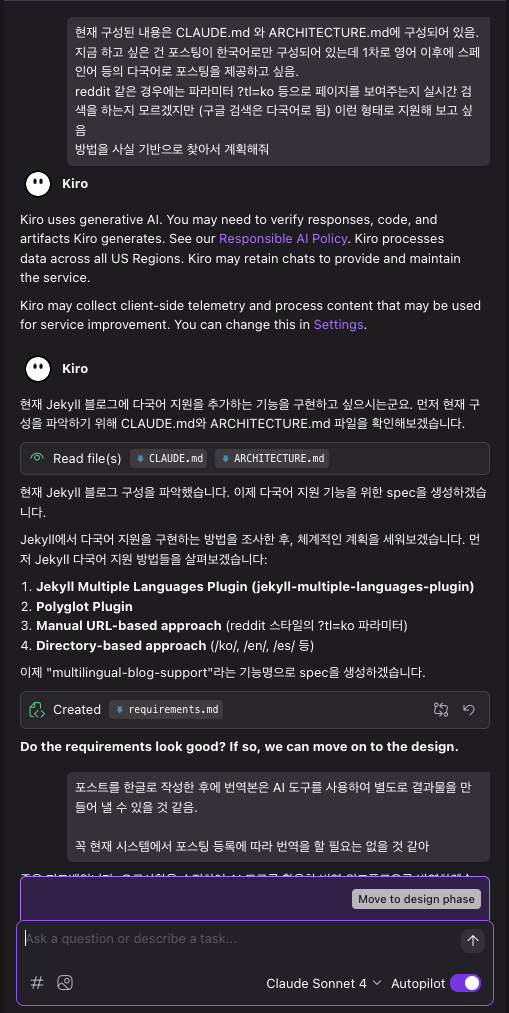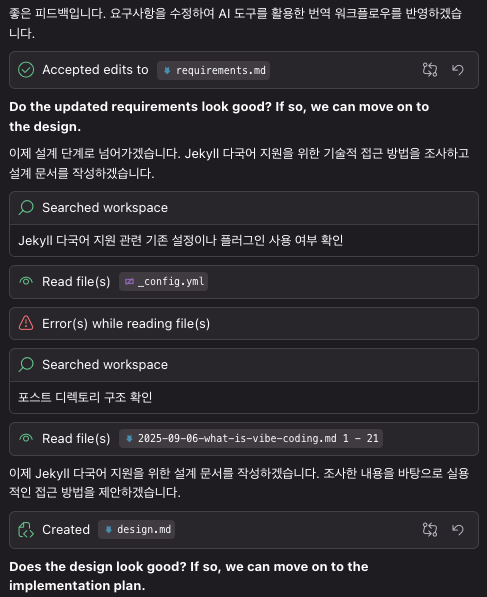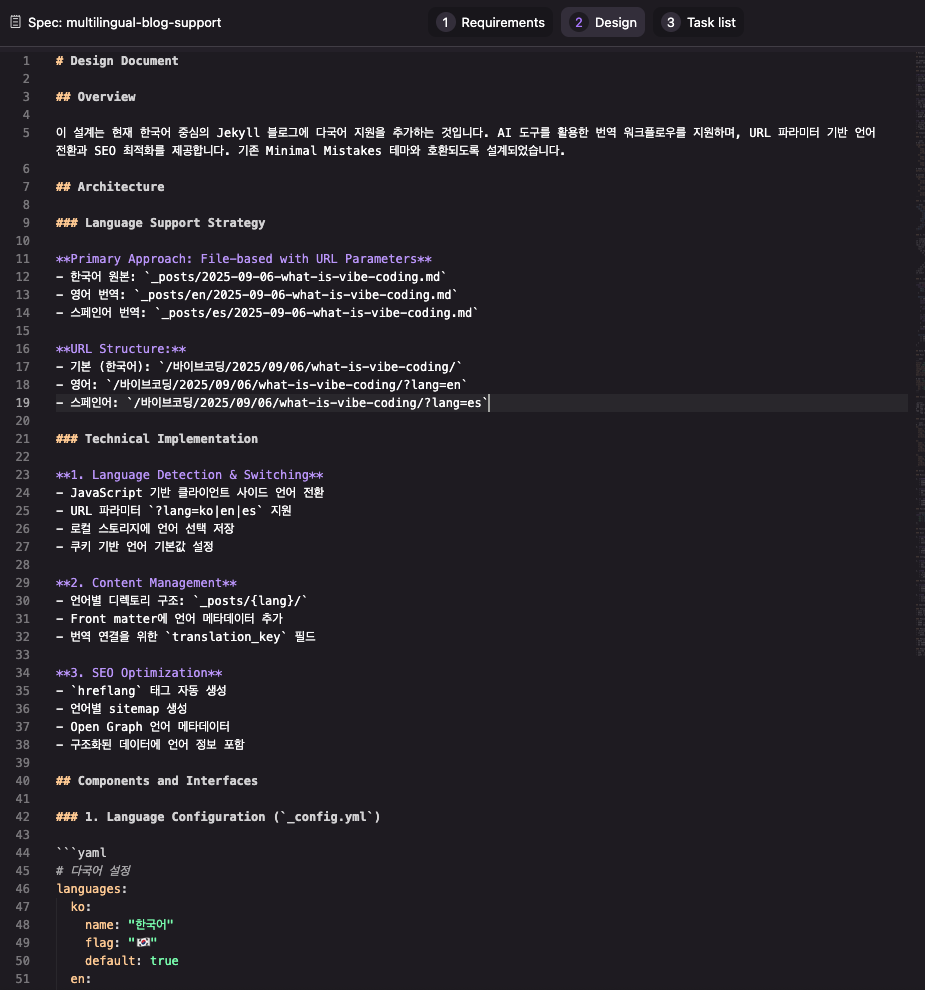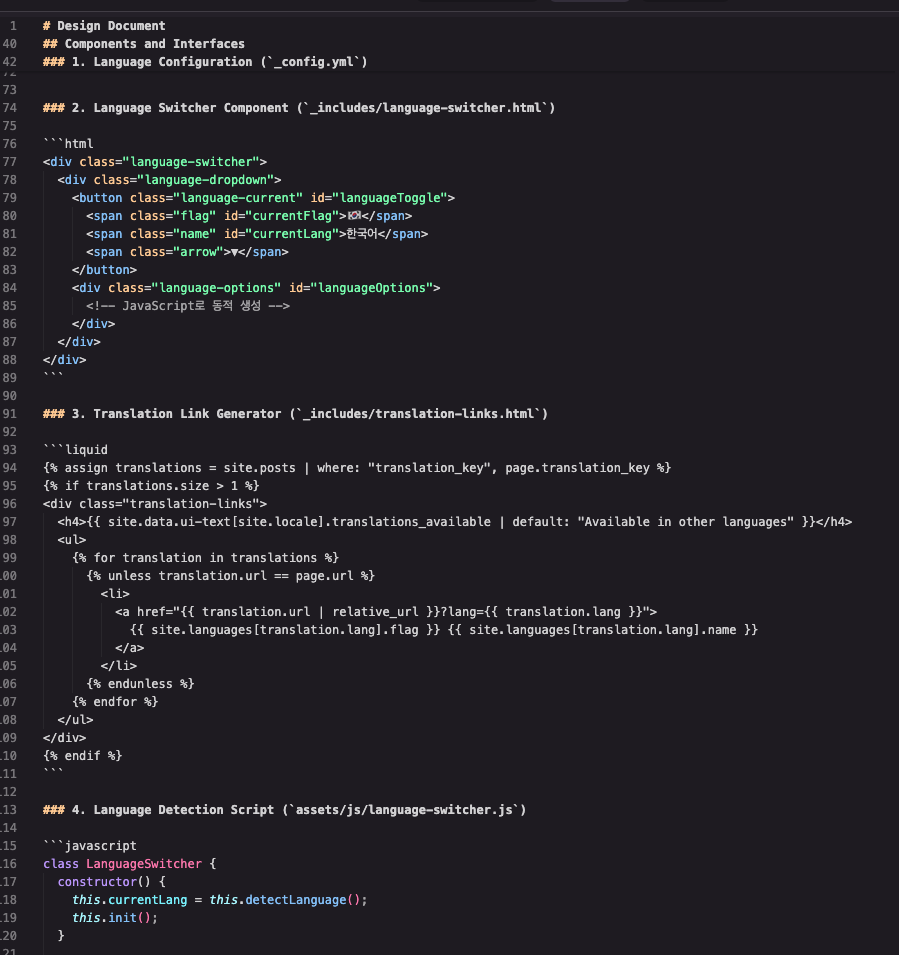My First Experience with Kiro Editor - Finally Got Off the Waitlist!
Hey there, LISA here! 🙂
Today, instead of the Task Master experience I originally planned to share, I’m bringing you an exciting story about a new AI development tool I just tried!
Finally Off the Kiro Waitlist! 🎉
I got my activation code for Kiro Editor that I applied for back in July! I was so excited that I jumped right in and… wow, this thing is absolutely amazing!
What’s Kiro?
Kiro is an AI development tool made by AWS. Unlike other AI tools, it offers two different development approaches:
- Vibe Mode: Free-flowing and improvisational development (the vibe coding we know and love!)
- Spec Mode: Systematic and step-by-step development (the mode I tried today!)
I used Spec Mode this time to build multilingual support for my blog.
First Experience: Entering the Prompt

Initially, I kept it simple. I typed something like “Add multilingual support to Jekyll blog.”
But then Kiro was like “Hold on, let’s first clarify exactly what you want, shall we?” and immediately moved to the requirements gathering phase!
Systematically Organizing Requirements

This was genuinely surprising. Kiro took my vague request and turned it into:
Requirement 1: Language-specific Post Viewing
- Users can view blog posts in their preferred language
- Default language is Korean, fallback to Korean version if no translation exists
- Maintain the same post/page context
Requirement 2: Language Switching Functionality
- Display language selector in navigation
- Clicking a language switches the entire site interface
- Navigate to translated version while maintaining current page context
Requirement 3: AI Translation Support
- Add AI translations to existing Korean posts
- Manage as separate translation files
- Independent editing for each language
Pretty systematic, right? I said “add multilingual support” in one sentence, and it broke it down this comprehensively!
Real-time Feedback is Perfect Too!

When I looked at the requirements and thought “hmm, I’d like to do this differently,” I gave feedback and it updated everything immediately.
When I used Task Master, this kind of real-time feedback was somewhat lacking, but with Kiro, you can naturally refine requirements through conversation, which was great.
The Design Phase is Super Detailed!

Once requirements are finalized, it immediately moves to the design phase, and this is as detailed as if a real developer designed it!
Language Support Strategy
- File-based with URL Parameters approach
- Korean original:
_posts/2025-09-06-what-is-vibe-coding.md - English translation:
_posts/en/2025-09-06-what-is-vibe-coding.md - Spanish translation:
_posts/es/2025-09-06-what-is-vibe-coding.md
URL Structure
- Default (Korean):
/바이브코딩/2025/09/06/what-is-vibe-coding/ - English:
/바이브코딩/2025/09/06/what-is-vibe-coding/?lang=en - Spanish:
/바이브코딩/2025/09/06/what-is-vibe-coding/?lang=es
It presents concrete implementation methods like this!
Shows Code and Modeling in Advance

The design document even shows the actual code to be implemented:
<div class="language-switcher">
<div class="language-dropdown">
<button class="language-current" id="languageToggle">
<span class="flag" id="currentFlag">🇰🇷</span>
<span class="name" id="currentLang">한국어</span>
<span class="arrow">▼</span>
</button>
<div class="language-options" id="languageOptions">
<!-- Dynamically generated with JavaScript -->
</div>
</div>
</div>

It also precisely designs the Front Matter structure:
---
title: "What is Vibe Coding? - A New Development Approach in the AI Era"
date: 2025-09-06
# Multilingual support fields
lang: "ko"
translation_key: "what-is-vibe-coding"
translations:
en: "/posts/en/2025-09-06-what-is-vibe-coding/"
es: "/posts/es/2025-09-06-what-is-vibe-coding/"
---
Much More Systematic Than Task Master!
Honestly, I felt much more confident than when using Task Master.
Most Impressive Aspect: Organic Integration
Task Master:
- Takes PRD and creates a bunch of tasks
- Throws each task to Claude Code
- When problems arise, it’s like “hmm… let me try again”
Kiro Spec Mode:
- Requirements → Design → Tasks are completely connected
- When requirements change, design updates automatically
- Design content converts directly to tasks
- All phases are managed consistently
This is really a huge difference! Task Master felt like each tool was working separately, but Kiro feels like everything is connected and running within one system.
Before starting work, you can clearly see “ah, this is how it’s going to be done” which is reassuring.
Preview of Next Post
In the next post, I’ll share:
- Actual Task execution process (how development proceeds)
- Completed results and testing
- Comparison with Cursor, Claude Code
- Complete pros and cons summary
The Task execution part is still coming, and that’s where the connectivity of Requirements-Design-Tasks really shines. Plus automatic testing!
📱 Keep Loving TipSmart Too!
Don’t forget about my first app made with existing AI tools! While exploring new tools, feedback on existing work is always precious 😊
Download TipSmart from App Store 📱
If this post was helpful, please share it on social media! It’ll help others who are curious about Kiro Editor!
